This spring, the Thriving Bays project conducted a unique measure test in Långbroviken. The researchers placed a plate at the mouth of the bay for a few months to investigate whether water currents and water level changes during spring are a main cause of the poor water quality. While waiting for the researchers’ data analyses, BalticWaters has met with some of the residents around the bay. They share the same opinion – the turbidity of the water has decreased significantly since the measure was implemented.
It’s an unusually warm September day when we arrive at Långbroviken on Värmdö. Much of the surrounding area is slowly starting to go into hibernation as autumn approaches. Many of the summer guests have left their piers and holiday homes, but outside the bay, large ferries and other boats continue to pass the bay, on their way in and out of Stockholm.
Earlier this year, the Living Bays project conducted a measure test here to investigate the cause of the poor water quality in the bay. The bay has long been characterised by turbid water, symptoms of eutrophication and sparse vegetation, and what was historically an important nursery for coastal fish has been replaced by an environment where fish find it difficult to reproduce.
While the scientists’ evaluation is underway, we have learnt that several residents have noticed exciting changes in the bay. So we travelled to Värmdö to meet Olof, Birgitta and Lasse, some of the people who live by the bay, to find out more.
How does turbid water affect vegetation and coastal fish stocks in shallow bays?
Turbidity reduces light penetration, favouring fast-growing species, while inhibiting sensitive plants such as coralline algae and eelgrass. These plants provide important habitats for coastal fish such as perch and pike, whose juveniles depend on them for shelter and food. When these habitats are disturbed or lost, fish stocks suffer, which in turn can negatively affect the entire coastal ecosystem.
Source: Länsstyrelsen
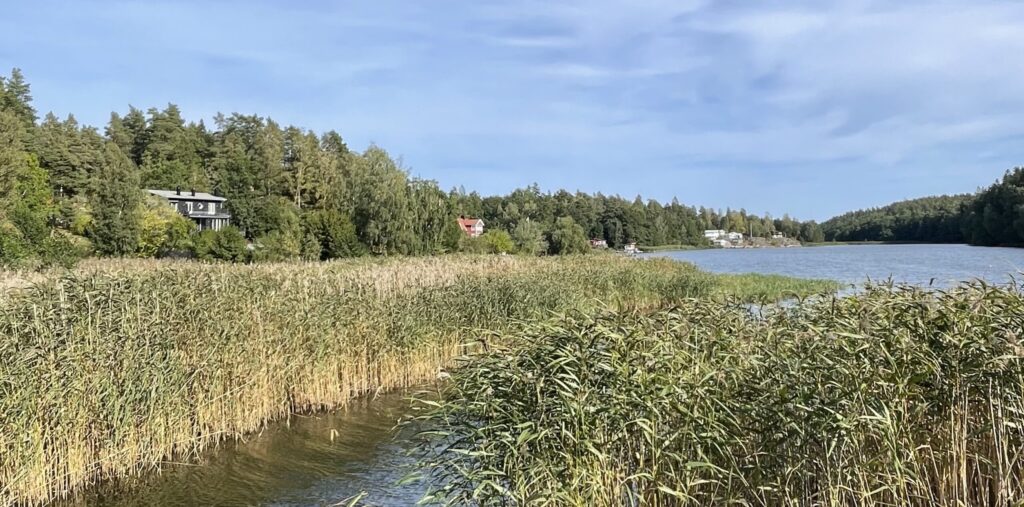
The inlet of Långbroviken. Photo: Ebba Rosendahl
Test of measure raises hopes for improvement
Birgitta grew up in Långbroviken and has followed the changes in the bay’s water environment for almost 70 years. For many years, she didn’t think much about the cause of the poor water quality, perhaps because that was the way it had always been.
– The vegetation in the bay has changed over time, but the water has always been more or less turbid for as long as I can remember, says Birgitta.
But over the past 15 years, she has started to think more about why it looks the way it does – a question that researchers in the Thriving Bays project are now seeking answers to.
Långbroviken was historically more open to the surrounding bay. The bay became more enclosed when a road bridge was built across the estuary in the 1950s, reducing water flow and changing water currents. The researchers believe that one reason for the turbidity may be strong water currents from ferry traffic and other sources, which cause erosion along the shoreline at the bridge abutment and inside the bay. To investigate this connection, the researchers placed a sheet of metal underneath the bridge that would cut off the mouth, thereby reducing water movement and inflow into the bay.
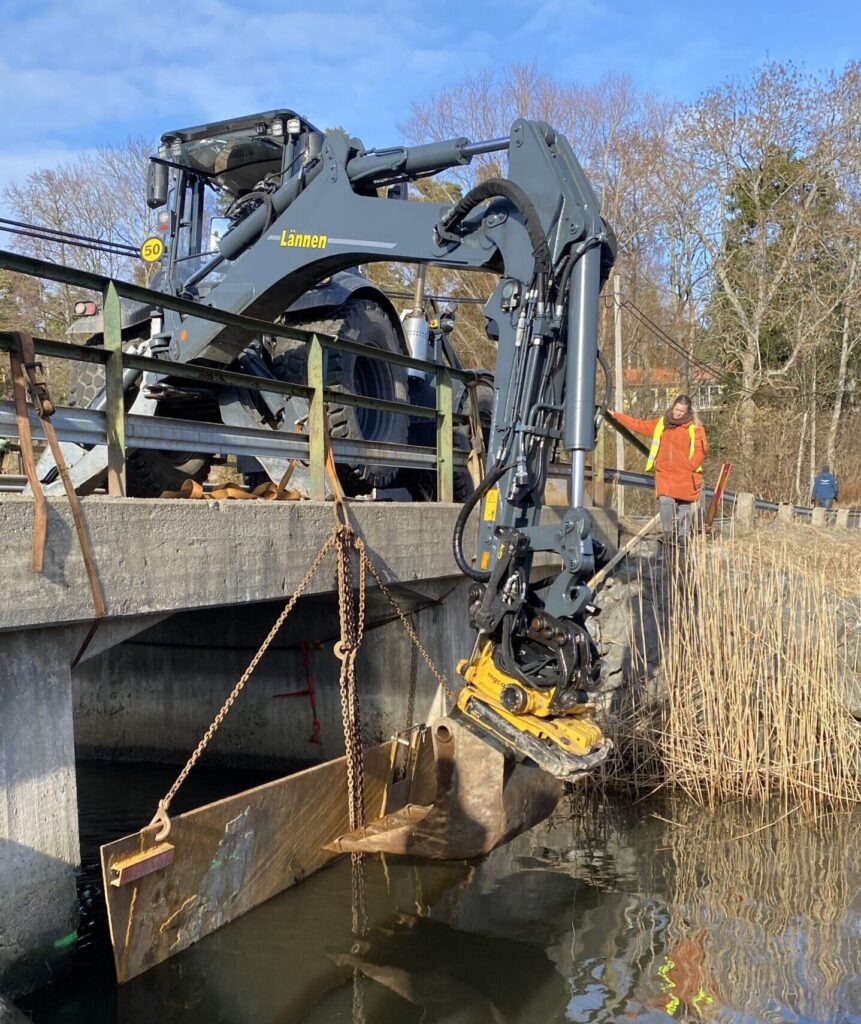
In February, the researchers in the project set up the plate at the road bridge over the inlet of Långbroviken. Photo: Linda Kumblad.
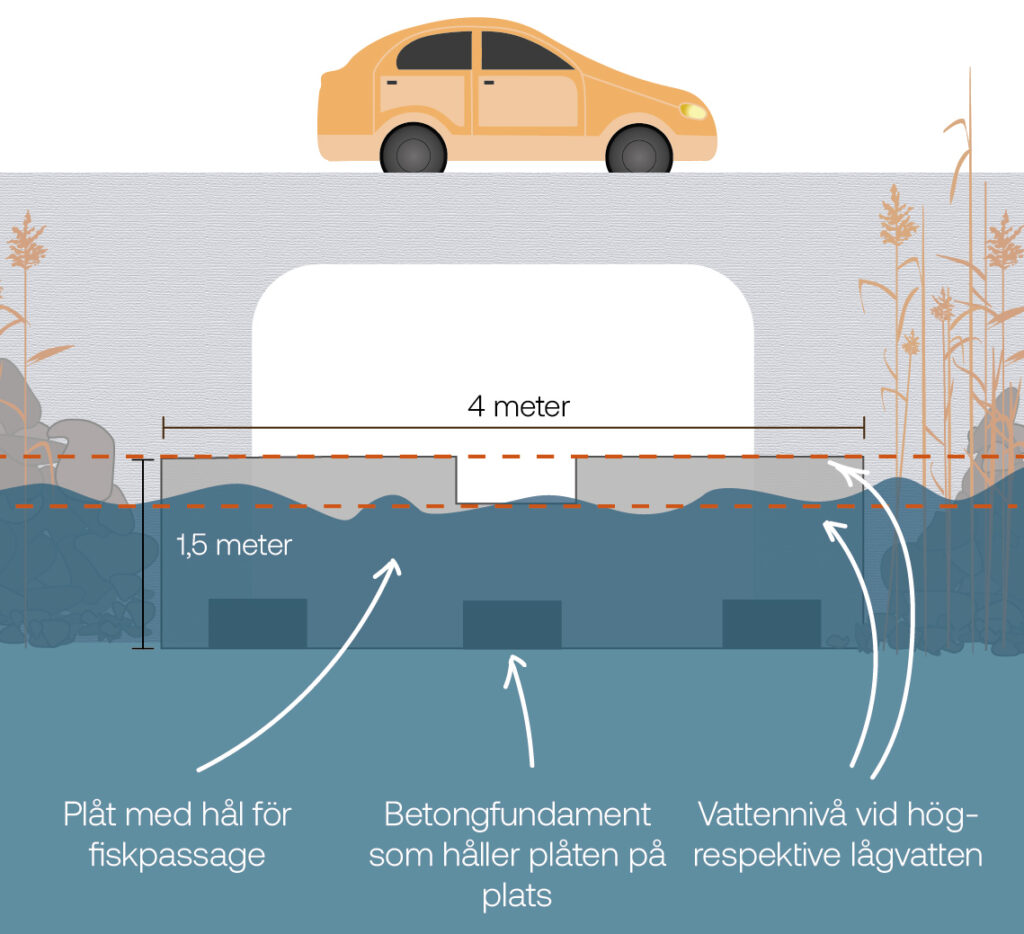
The plate was placed close to the bridge foundation and secured with free-standing concrete foundations anchored to the bottom on the opposite side of the bridge. Illustration: Madeleine Kullenbo, BalticWaters.
Plåt med hål för fiskpassage = Plate with holes for fish passage
Betongfundament som håller plåten på plats = Concrete foundation to hold the sheet in place
Vattennivå vid hög- respektive lågvatten = Water level at high and low tide
Want to know more about how the plate was put in place in Långbroviken? Read and see more here!
Naturally, there was a great deal of interest in the work among residents around the bay. Olof, who has lived in the bay for almost 26 years, says that the test brought a sense of cautious anticipation.
– Of course I hoped that the measure would lead to an improvement, but at the same time I was prepared for the fact that it might not produce any immediate results, he says.
– It was almost like buying a lottery ticket, he explains. You hope for a win, but don’t really have the nerve to believe that it will happen.
Birgitta agrees.
– I felt optimistic that the project could help our bay. But you never know with tests like this, it’s hard to know in advance whether it will produce results, she says.
The water clears – from one day to the next
The plate was installed under the bridge to the inlet in February and was to remain there until just before midsummer. During the first few months, neither Olof, Birgitta nor Lasse noticed any noticeable difference, but the water remained as murky as before. Time passed and it was not until the week before the plate was to be taken down that something happened – and suddenly.
– Before, there was practically no visibility at all. Now I can even see my feet when I rest vertically in the water! he says with a marvellous laugh.
– The water was murky all spring, but then almost from one day to the next, the it became much clearer, says Olof, who is fascinated by how quickly the change came.
It wasn’t just their own feet that residents could now see in the clearer water, other things below the surface began to emerge too. Lasse, who lives with Birgitta, says:
– Now we see fish in the bay every day! Before, you could barely see anything through the murky water, but now you can stand by the jetty and actually see the fish swimming around among the plants, says Lasse.
Olof also says that the vegetation in the bay has changed in connection with the measure test.
– Now the seabed is covered with low-growing underwater plants instead of meandering plants that reach the surface, now I can swim freely!
When we meet Olof, Birgitta and Lasse in early September, a couple of months after the researchers removed the plate, they tell us that the positive effect is still there.
We were prepared for the effect to diminish when the plate was removed, especially since the turbidity tends to increase during the summer when the temperature rises, but the water is still clear, says Lasse.
Olof and Lasse share the changes they observed in Långbroviken after the measure test [In Swedish]. Video: Ebba Rosendahl
Observations can strengthen scientific evaluation
The researchers in the project collected data before, during and after the test period to evaluate the impact of the measure on water quality. Among other things, the researchers monitored changes in the levels of phosphorus and nitrogen in the water, two nutrients that contribute to eutrophication symptoms. They also monitored chlorophyll levels, which serve as a measure of phytoplankton abundance.
Once the data collection is complete later this autumn, the researchers’ analysis work awaits. Linda Kumblad, project manager for Thriving Bays, hopes that the scientific results can contribute important knowledge about the way forward to improve the environment in Långbroviken – and similar bays along the Baltic coast.
However, residents’ observations also play an important role in the evaluation of the measure.
– We are conducting our scientific evaluations, and if the observations of the bay residents are consistent with our data, it gives the results more weight, she explains.
This is very important information for us. The residents have the water at their doorstep and can notice small changes in the water from day to day, says Linda.
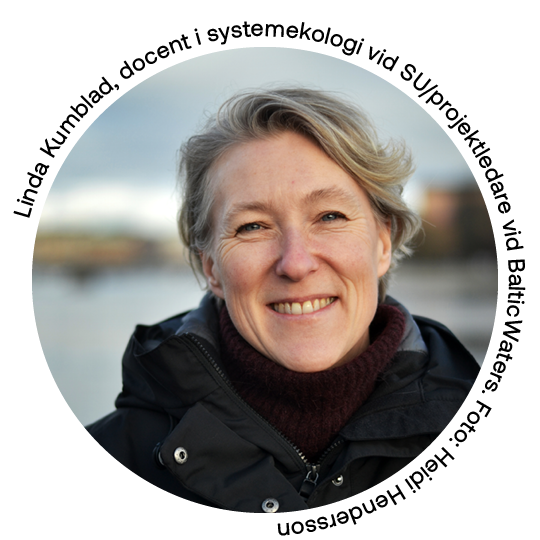
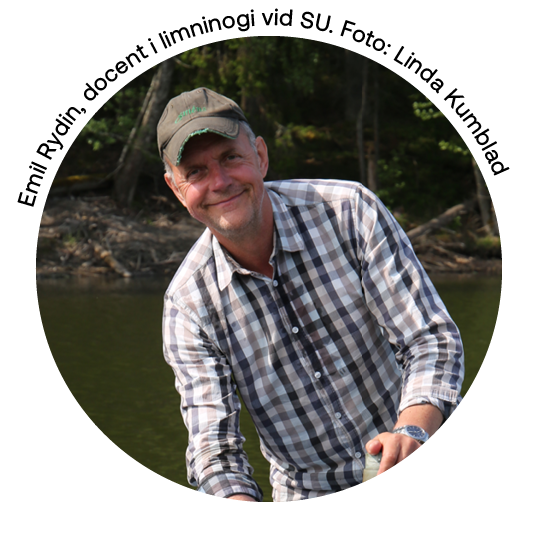
While awaiting the results, the researchers are exploring options to continue the intervention work, but much remains uncertain and it is too early to say what the future holds.
– If it turns out that the patch has had a positive effect, it would be interesting to do another test. This would help us to better understand how we can find a more permanent solution that can also be used in other bays with similar problems, says Emil Rydin, researcher in the project.
Olof, Birgitta and Lasse are also positive about the possibility of continued work on measures in Långbroviken, although they see some practical challenges.
– I think there is broad support among the residents here. Everyone I’ve spoken to seems to appreciate that something is being done to improve the environment in the bay, says Olof.
Lasse agrees, but emphasises that it must not be too difficult to get out on the boat.
If the measure proves to improve the water quality and favour the fish in the bay, I am completely open to it, says Lasse.

More about Thriving Bays
Långbroviken has been selected by the Living Bays project as one of four bays that researchers will restore to try to regain good water quality and underwater habitat. The aim of the project is to present which measures are suitable for improving the environmental quality of shallow bays, how effective different measures are and what is required to implement them. The project will produce practical advice for municipalities and county administrative boards as well as individual homeowners and communities who want to restore ‘their’ bay. Living Bays is funded and run by the BalticWaters Foundation in collaboration with Stockholm University’s Baltic Sea Centre, with support from the Stockholm County Administrative Board, the Uppsala County Administrative Board and the Swedish Agency for Marine and Water Management.

